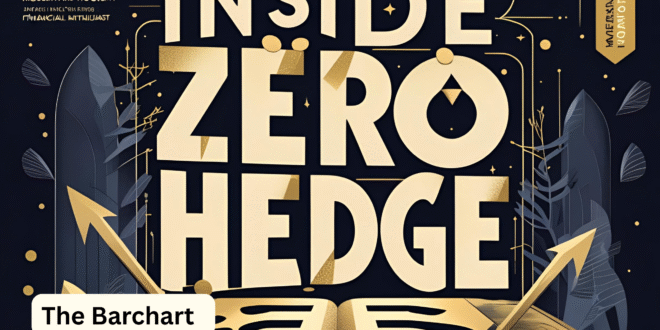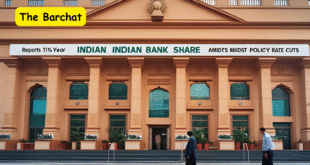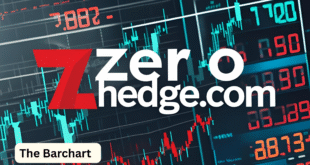Zero Hedge has emerged as a powerful and controversial voice in the world of financial journalism.
Known for its anonymous authorship and unfiltered tone, the platform challenges mainstream economic narratives and offers deep dives into market trends, political developments, and global financial systems.
With a loyal audience drawn to its contrarian perspective, Zero Hedge often questions central banks, corporate power, and government policies.
While critics argue it promotes fear-driven content, supporters see it as a rare outlet for independent thinking.
Inside Zero Hedge lies a unique blend of skepticism, analysis, and bold commentary that continues to stir debate in financial circles.
What Is Zero Hedge? A Closer Look at the Controversial Finance Blog
Zero Hedge is a widely known financial blog that offers an alternative take on global markets, economics, and geopolitics.
Launched in 2009, it quickly gained traction for its anti-establishment tone and skepticism toward mainstream financial narratives.
Zero hedge is known for publishing bold headlines, anonymous analyses, and unfiltered commentary on topics often overlooked by traditional media.
While some hail the platform for its transparency and data-rich content, others criticize it for being alarmist or politically biased.
Despite the divided opinions, Zero Hedge has managed to build a loyal following among investors, analysts, and market skeptics who value its contrarian insights.
Whether discussing central bank policies or market manipulation theories, Zero Hedge consistently challenges the status quo, making it a unique voice in the crowded world of financial journalism.
Its popularity has only grown with increasing public distrust in mainstream institutions.
The Origins of Zero Hedge: Who Really Created It and Why

The creation of Zero Hedge is shrouded in intrigue, with its founders initially hiding behind the pseudonym “Tyler Durden,” a nod to the rebellious character from Fight Club.
Eventually, Bulgarian-born Daniel Ivandjiiski was identified as a key figure behind the site.
Ivandjiiski, a former hedge fund analyst, reportedly launched Zero Hedge in response to what he perceived as manipulation and corruption in global financial systems.
The blog served as a vehicle to expose flawed economic policies and provide a raw, unfiltered outlook on Wall Street’s inner workings.
Zero hedge positioned itself as a platform for whistleblowers, rogue traders, and financial skeptics who shared a common distrust of centralized power.
Its anonymity, once criticized, also gave contributors the freedom to voice unpopular opinions.
Over time, this bold stance made the blog an essential resource for contrarian thinkers and market realists, shaping how many now perceive mainstream finance and politics.
Why Zero Hedge Stands Out in the World of Financial News
In a digital landscape saturated with financial media outlets, Zero Hedge has carved out a distinct niche by embracing a confrontational, anti-mainstream voice.
Unlike traditional platforms that rely heavily on corporate sponsors or regulatory tone, Zero hedge delivers news and analysis with minimal filter and maximal skepticism.
Its articles often blend market data with bold predictions, conspiracy theories, and critiques of central banking practices.
This unique style attracts readers seeking alternative perspectives, especially those disillusioned by traditional economic narratives.
Furthermore, its coverage of global issues often includes topics that mainstream media avoids or underplays, which helps it stay relevant and compelling.
Zero Hedge’s persistent questioning of authority and status quo resonates with a global audience increasingly critical of institutional control.
By offering detailed breakdowns of market activity with a contrarian lens, Zero Hedge manages to stand out as a voice of financial rebellion amid a sea of consensus journalism.
Zero Hedge and Its Influence on Market Skepticism
Zero Hedge has significantly influenced how retail traders and even institutional investors view financial markets.
Known for highlighting systemic risks, unsustainable debt patterns, and questionable central bank interventions, Zero hedge encourages a skeptical approach to market narratives.
The platform’s readers often walk away with a sense of caution rather than optimism, which plays a pivotal role in shaping investment behavior, particularly in volatile times.
Traders use the blog’s data-rich posts and analytical charts as tools to hedge against bullish mainstream forecasts.
Moreover, its deep dives into government policies and their unintended consequences help users understand potential long-term risks.
Although some critics argue that it fosters fear and uncertainty, others see it as a necessary check against overly positive financial media.
Zero Hedge’s presence has undoubtedly amplified contrarian sentiment, giving rise to a new wave of market participants who prefer data-driven skepticism over blind optimism.
Common Themes and Narratives Found on Zero Hedge
Zero Hedge is renowned for recurring themes that challenge mainstream economic thought.
These include strong critiques of central bank actions, especially quantitative easing and low interest rates, which zero often argues lead to asset bubbles and income inequality.
The blog also routinely discusses geopolitical tensions, surveillance capitalism, and systemic risks in global financial institutions.
Additionally, it highlights topics like debt saturation, gold investment, and the dangers of fiat currencies.
The tone is frequently urgent, prompting readers to question the longevity of current economic models.
By providing detailed charts and historical parallels, the site supports its often grim outlooks with data and context.
Its consistent narrative warns of looming crises and encourages financial preparedness, which has built a community of readers who value foresight over comfort.
This blend of skepticism and data has made a go-to source for those who distrust glossy financial optimism and prefer hard-hitting truths.
Criticism and Support: The Polarizing Nature of Zero Hedge
Zero has faced both harsh criticism and fervent support, making it one of the most polarizing platforms in financial journalism.
Critics argue that often leans toward sensationalism, conspiracy theories, and politically charged rhetoric.
Some accuse it of promoting fear and paranoia, especially during economic downturns or geopolitical events.
On the flip side, supporters commend the site for daring to challenge institutional narratives and uncover stories that others ignore.
Many praise its in-depth market analysis and commitment to transparency, particularly through the use of raw data and alternative viewpoints.
The blog’s anonymous contributors further add to its mystique, though this anonymity has also drawn suspicion.
Regardless of opinion has undeniably impacted financial discourse, pushing both retail and institutional readers to question information sources.
Its influence, while controversial, highlights the growing demand for media that breaks away from consensus and dives into contrarian truths.
Zero Hedge’s Role During Financial Crises and Market Volatility
In times of economic uncertainty, Zero becomes a focal point for traders and analysts seeking unfiltered insights.
During the 2008 financial crisis, zero hedge gained popularity for exposing issues like mortgage fraud, bank insolvency, and opaque financial products.
It continued to grow during subsequent events like the European debt crisis, COVID-19 market crash, and inflation spikes.
Unlike mainstream outlets that often reassure the public, delivers harsh realities backed by data, fostering preparedness over panic.
This approach has made it a reliable source for understanding the underlying mechanics behind market turmoil.
The blog frequently offers detailed reports on liquidity shortages, bond market stress, and systemic risks that traditional media underrepresents.</span>
<p><span style=”font-weight: 400;”>As a result, many investors now turn to Zero Hedge during high-volatility periods to gain a broader, often more critical perspective.
Its consistent focus on risk and financial fragility cements its reputation as a crisis-time companion for wary market watchers.
Comparing Zero Hedge with Mainstream Financial Media Outlets
Compar
ed to mainstream financial platforms like Bloomberg or CNBC, Zero Hedge offers a starkly different tone and approach.
While traditional outlets prioritize polished reporting, regulatory alignment, and advertiser-safe content, hedge leans into raw commentary and contrarian analysis.
It often covers the same events but frames them with skepticism, questioning motives and highlighting overlooked implications.
This difference in editorial philosophy attracts readers who feel mainstream media downplays or omits key issues.
Moreover, Zero is not bound by corporate affiliations, allowing it greater freedom to critique powerful institutions without conflict of interest.
Its frequent use of anonymous sources and independent research adds a grassroots element to its credibility among contrarian thinkers.
While mainstream platforms offer investor sentiment and corporate-friendly insights, Zero Hedge appeals to those craving authenticity and alarm bells.
Despite—or because of—these differences, both types of media coexist, fulfilling the diverse information needs of the modern financial audience.
How Zero Hedge Uses Charts and Data to Strengthen Its Narrative
Data visualization plays a central role in Zero Hedge’s reporting style.
Whether it’s highlighting inflation trends, market crashes, or economic forecasts, zero hedge frequently relies on charts and graphs to back its arguments.
These visuals are often embedded within articles to offer readers a clear, empirical look at market behavior and economic shifts.
The blog’s use of real-time data, often sourced from institutions like the Federal Reserve or major trading platforms, adds a layer of credibility to its contrarian takes.
Instead of vague claims, Zero Hedge provides numbers, patterns, and timelines to illustrate financial risks or policy impacts.
This approach allows readers to draw their own conclusions while being guided by context and analysis.
It also helps build trust among those who demand evidence-based commentary.
In a digital age where readers are flooded with opinions, Zero Hedge’s data-rich presentation helps it cut through the noise with clarity and focus.
The Future of Zero Hedge: Relevance in a Changing Media Landscape

As media consumption evolves, Zero Hedge faces new challenges and opportunities.
The rise of AI-generated news, increased censorship, and changing reader habits mean that zero hedge must adapt to remain influential.
However, its core strength—offering bold, data-driven perspectives—remains relevant.
The growing distrust in mainstream narratives plays in its favor, as more people seek unfiltered, independent analysis.
Zero may expand into video, podcasts, or decentralized platforms to broaden its reach and engagement.
Additionally, increased global attention to market instability and inflation ensures continued demand for its content.
As financial journalism becomes more corporatized, platforms like offer a critical counterbalance.
Its longevity will depend on maintaining trust, updating content formats, and retaining the unique voice that made it popular in the first place.
While the media world shifts rapidly, role as the voice of financial dissent shows no signs of fading away.
(FAQs)
Q1: What is Zero Hedge known for?
A: Zero Hedge is known for its contrarian financial analysis and critical take on mainstream economic policies.
Q2: Is Zero Hedge a reliable source?
A: It depends on the reader’s perspective; some see it as eye-opening, while others view it as alarmist.
Q3: Who runs Zero Hedge?
A: It was founded by Daniel Ivandjiiski, but many contributors remain anonymous under the pseudonym “Tyler Durden.”
Q4: Does Zero Hedge influence the stock market?
A: It influences investor sentiment, especially among retail traders and market skeptics.
Q5: Why is Zero Hedge controversial?
A: Due to its anonymous authorship, sensational tone, and focus on exposing financial and political flaws.




